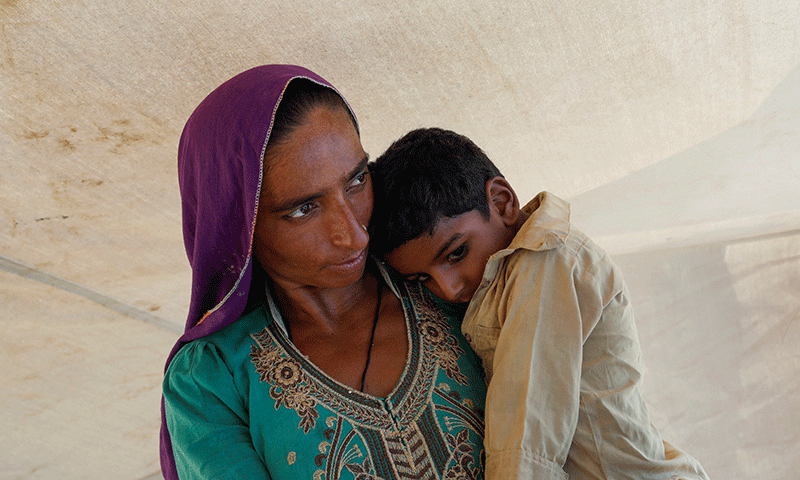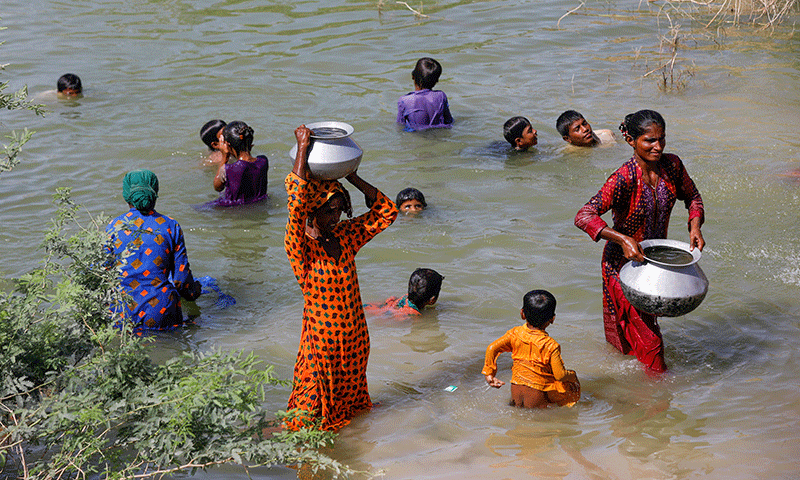September 19, 2022
ISLAMABAD – The World Health Organisation (WHO) has sounded the alarm over an impending “second disaster” of disease and death as concerns grow over the spread of water-borne diseases among the flood-hit people in Sindh.
The warning, issued late on Saturday by WHO Director General Tedros Adhanom Ghebreyesus, comes after Prime Minister Shehbaz Sharif called on the nation to generously donate baby food and blankets for flood-affected people on an urgent basis.
In the statement, the WHO chief also urged donors to continue to respond generously to “save lives and prevent more suffering”.
He highlighted that the water supply was disrupted in flood-hit areas, forcing people to drink unsafe water which could cause cholera and other diseases.
Key developments:
- WHO seeks more aid for flood-hit people
- Over 2.5m people treated at Sindh medical camps so far
- Water level in Manchhar Lake reduces to 120.9-RL
- Various villages in Dadu, Sehwan still have 10-feet stagnant water
- Planning Minister Ahsan Iqbal discusses flood situation with Sindh CM
- Australia announces additional $3m aid
Stagnant water serves as a breeding ground for mosquitoes and spreads vector-borne diseases such as malaria and dengue, he warned.
“Health centres have been flooded, their supplies damaged, and people have moved away from home which makes it harder for them to access their normal health services.”
He pointed out that health workers in the country were stretched to the limit as they did all they could do to deliver critical services amid the destruction. “Nearly 2,000 health facilities have been fully or partially damaged.”
He said the WHO had provided water purification kits and oral rehydration salts to manage diarrhoeal diseases.

A medical camp of SIUT in Dadu. — Photo by Qurban Ali Khushik
WHO immediately released $10 million from the WHO Contingency Fund for Emergencies which enabled us to deliver essential medicines and other supplies to the country, he added.
He also thanked donors for their “prompt response” to the United Nations’ flash appeal. “We continue to assess the scale of the crisis and will issue a revised appeal shortly,” he said.
Another 90,000 patients treated in a day in Sindh
The Sindh health department, meanwhile, said a total of 2.5 million patients had been treated at different medical camps across the province from July 1 to date.
As many as 594,241 patients were treated for skin-related diseases, followed by diarrhoea (534,800), malaria (10,702), dengue (1,401), and other diseases (120,745,1), stated a report by the Sindh Directorate General Health Services.
The report also showed that 90,398 patients were treated during the last 24 hours, of which 17,919 had diarrhoea, 19,746 had skin-related diseases, 695 had malaria and 388 had dengue.
Around 92,797 citizens were treated in the province on September 15.
Speaking to Dawn.com, Dadu District Health Officer (DHO) Dr Muhammad Ali Samejo said different diseases, mainly gastro and malaria, were being reported among the district’s flood-hit people.

A displaced woman holds her ailing boy, while taking refuge in a camp, following rains and floods during the monsoon season in Sehwan on Friday (Sep 16). — Reuters
Dr Irshad Memon, an officer at a medical camp in Dadu, said at least 18,289 pregnant women had been screened from Aug 25 to Sep 17.
Dr Karim Mirani, who works for Dadu Civil Hospital, told Dawn.com that the hospital had been flooded with patients due to rampant disease spread. “We are accommodating four to five children on a single bed due to the huge influx of patients,” he said.
Floods from record monsoon rains and glacial melt in the mountainous north have affected 33 million people and killed more than 1,540 since June 14, washing away homes, roads, railways, livestock and crops, in damage estimated at $30 billion.
Both the government and UN Secretary-General Antonio Guterres have blamed climate change for the extreme weather that led to the flooding, which submerged nearly a third of the country.

Locals receive medicines at a medical camp in Dadu. — Photo by Qurban Ali Khushik
Sindh has been particularly hit hard, with the province’s Manchhar Lake — the largest freshwater lake in the country — witnessing a surge in its water level in recent days as floodwaters from the north and hill torrents from Balochistan flow southwards, leaving behind a trail of deaths and destruction.
Hundreds of thousands of people have been made homeless by flooding in Sindh, with many sleeping by the side of elevated highways to protect themselves from the water.
Water receding in parts of Sindh
According to the in charge of the irrigation cell for Manchhar Lake, Sher Mohammad Mallah, the water level in Manchhar Lake was recorded as 120.9-foot reduced level on Sunday morning, down from 121.5RL on Saturday evening.

Displaced women carry water pots as children take bath amid floodwater, while they take refuge in a camp, following rains and floods during the monsoon season in Sehwan on Friday (Sep 16). — Reuters
Similarly, the water level in Main Nara Valley Drain (MNVD), commonly known as Right Bank Outfall Drain-I, at RD-10 upstream Manchhar, was also decreasing gradually with each passing day.
Dadu Deputy Commissioner (DC) Syed Murtaza Ali Shah told Dawn.com that the water level had also decreased by at least three feet in Khairpur Nathanshah, Dadu, Mehar, and Johi areas.
However, the locals said the water was still stagnant in Sehwan and Dadu.
Planning minister meets Sindh CM
Meanwhile, Planning Minister Ahsan Iqbal met Sindh Chief Minister Murad Ali Shah in Karachi where the two discussed the current flooding situation and relief operations.
Iqbal said that the prime minister had instructed him to stay in touch with Shah and added that the federal government would fully help in providing the urgently needed goods.
CM Shah informed the planning minister that 1.5 million tents were currently needed while only 250,000 had been provided so far. He also spoke on the need to restore the road and rail network to ensure the delivery of necessary items to which Iqbal assured him that restoration work had started.
وزیر اعلی سندھ مراد علی شاہ سے کراچی میں ملاقات میں صوبہ سندھ میں سیلاب کے متاثرین کے لئے وفاقی حکومت کے تعاون کی بھرپور یقین دہانی کروائی اور امدادی کاروائیوں کو موثر بنانے کے اقدامات پہ گفتگو کی۔ pic.twitter.com/kWTD9Jn6HZ
— Ahsan Iqbal (@betterpakistan) September 18, 2022
Australia announces additional aid
Meanwhile, the government of Australia announced an additional $3 million for relief and rehabilitation of flood-hit people, according to a statement issued by the Pakistani High Commission in Canberra.
“The Australian assistance will be delivered through the World Food Programme,” it added. Australia had earlier provided $2m in relief assistance to the country.
The high commission said the government and the people of Pakistan were thankful to Australia for its solidarity in the wake of devastating floods caused by climate change.


